- Analytics
- News and Tools
- Market News
- Canadian Dollar still up for the week but struggles to hold onto gains on Friday
Canadian Dollar still up for the week but struggles to hold onto gains on Friday
- The CAD caught a bounce on risk appetite in early Friday trading.
- Industrial inflation figures in Canada print better than expected.
- US Dollar, Fed reaction is driving the market today.
The Canadian Dollar (CAD) is looking to pare back some of Thursday’s losses, catching some support from bolstered Crude OIl bids, but downside risks remain.
The Loonie is up about half a percent against the US Dollar (USD) for the week.
Canadian industrial inflation figures went head-to-head with US housing data Friday morning, but overall, risk sentiment appears to be the primary driver of moment-to-moment market moves.
Daily Digest Market Movers: Canadian Dollar unable to develop long legs to round out the week
- Canada’s Raw Material Price Index for October showed a 2.5% decline after September’s 3.9% jump (revised from 3.5%).
- Month-on-month Industrial Product Prices into October similarly declined 1%, contracting from the previous 0.4%.
- US Building Permits and US Housing starts both beat expectations, helping to arrest the Greenback’s early Friday slide and capping off CAD gains.
- US economy showed 1.487 million new building permits, beating the forecast of 1.45 million and clearing the previous month’s 1.471 million.
- US monthly Housing Starts also showed improvement, printing at 1.372 million versus the forecast for 1.35 million. September saw ground broken on 1.346 million new residential buildings.
- Crude Oil is seeing some lift on Friday, bolstered by rumors of additional EU sanctions on Russian Crude Oil exports.
- A back-and-forth trading week leaves the CAD strung along Friday’s mid-range.
- The overall trading week was also middling for the Loonie as the USD drove broad-market momentum.
Technical Analysis: Canadian Dollar strung along the middle for Friday as markets second-guess direction
The Canadian Dollar (CAD) is testing chart territory below 1.3750 against the US Dollar (USD), but the day’s Loonie bids are coming under threat as USD/CAD bidders make a feeble push.
The USD/CAD hit a daily low of 1.3708 before seeing a thin rebound toward 1.3740.
The pair hit a mid-week high near 1.3780 on Thursday, and CAD bidders have been struggling to pare away the bounce from the mid-week low near 1.3660.
Daily candlesticks have the USD/CAD consolidating in rough trading just above the 50-day Simple Moving Average (SMA), and technical indicators are beginning to grind toward the middle.
USD/CAD Hourly Chart

USD/CAD Daily Chart

Canadian Dollar price this week
The table below shows the percentage change of Canadian Dollar (CAD) against listed major currencies this week. Canadian Dollar was the strongest against the US Dollar.
| USD | EUR | GBP | CAD | AUD | JPY | NZD | CHF | |
| USD | -1.78% | -1.64% | -0.42% | -2.03% | -1.13% | -1.29% | -1.72% | |
| EUR | 1.75% | 0.13% | 1.32% | -0.24% | 0.64% | 0.48% | 0.06% | |
| GBP | 1.61% | -0.14% | 1.19% | -0.38% | 0.49% | 0.35% | -0.08% | |
| CAD | 0.42% | -1.35% | -1.21% | -1.59% | -0.71% | -0.86% | -1.29% | |
| AUD | 1.98% | 0.24% | 0.37% | 1.56% | 0.87% | 0.72% | 0.29% | |
| JPY | 1.11% | -0.63% | -0.48% | 0.69% | -0.90% | -0.12% | -0.58% | |
| NZD | 1.27% | -0.49% | -0.36% | 0.83% | -0.73% | 0.14% | -0.43% | |
| CHF | 1.68% | -0.07% | 0.07% | 1.26% | -0.32% | 0.56% | 0.41% |
The heat map shows percentage changes of major currencies against each other. The base currency is picked from the left column, while the quote currency is picked from the top row. For example, if you pick the Euro from the left column and move along the horizontal line to the Japanese Yen, the percentage change displayed in the box will represent EUR (base)/JPY (quote).
Canadian Dollar FAQs
What key factors drive the Canadian Dollar?
The key factors driving the Canadian Dollar (CAD) are the level of interest rates set by the Bank of Canada (BoC), the price of Oil, Canada’s largest export, the health of its economy, inflation and the Trade Balance, which is the difference between the value of Canada’s exports versus its imports. Other factors include market sentiment – whether investors are taking on more risky assets (risk-on) or seeking safe-havens (risk-off) – with risk-on being CAD-positive. As its largest trading partner, the health of the US economy is also a key factor influencing the Canadian Dollar.
How do the decisions of the Bank of Canada impact the Canadian Dollar?
The Bank of Canada (BoC) has a significant influence on the Canadian Dollar by setting the level of interest rates that banks can lend to one another. This influences the level of interest rates for everyone. The main goal of the BoC is to maintain inflation at 1-3% by adjusting interest rates up or down. Relatively higher interest rates tend to be positive for the CAD. The Bank of Canada can also use quantitative easing and tightening to influence credit conditions, with the former CAD-negative and the latter CAD-positive.
How does the price of Oil impact the Canadian Dollar?
The price of Oil is a key factor impacting the value of the Canadian Dollar. Petroleum is Canada’s biggest export, so Oil price tends to have an immediate impact on the CAD value. Generally, if Oil price rises CAD also goes up, as aggregate demand for the currency increases. The opposite is the case if the price of Oil falls. Higher Oil prices also tend to result in a greater likelihood of a positive Trade Balance, which is also supportive of the CAD.
How does inflation data impact the value of the Canadian Dollar?
While inflation had always traditionally been thought of as a negative factor for a currency since it lowers the value of money, the opposite has actually been the case in modern times with the relaxation of cross-border capital controls. Higher inflation tends to lead central banks to put up interest rates which attracts more capital inflows from global investors seeking a lucrative place to keep their money. This increases demand for the local currency, which in Canada’s case is the Canadian Dollar.
How does economic data influence the value of the Canadian Dollar?
Macroeconomic data releases gauge the health of the economy and can have an impact on the Canadian Dollar. Indicators such as GDP, Manufacturing and Services PMIs, employment, and consumer sentiment surveys can all influence the direction of the CAD. A strong economy is good for the Canadian Dollar. Not only does it attract more foreign investment but it may encourage the Bank of Canada to put up interest rates, leading to a stronger currency. If economic data is weak, however, the CAD is likely to fall.
© 2000-2024. Уcі права захищені.
Cайт знаходитьcя під керуванням TeleTrade DJ. LLC 2351 LLC 2022 (Euro House, Richmond Hill Road, Kingstown, VC0100, St. Vincent and the Grenadines).
Інформація, предcтавлена на cайті, не є підcтавою для прийняття інвеcтиційних рішень і надана виключно для ознайомлення.
Компанія не обcлуговує та не надає cервіc клієнтам, які є резидентами US, Канади, Ірану, Ємену та країн, внеcених до чорного cпиcку FATF.
Проведення торгових операцій на фінанcових ринках з маржинальними фінанcовими інcтрументами відкриває широкі можливоcті і дає змогу інвеcторам, готовим піти на ризик, отримувати виcокий прибуток. Але водночаc воно неcе потенційно виcокий рівень ризику отримання збитків. Тому перед початком торгівлі cлід відповідально підійти до вирішення питання щодо вибору інвеcтиційної cтратегії з урахуванням наявних реcурcів.
Викориcтання інформації: при повному або чаcтковому викориcтанні матеріалів cайту поcилання на TeleTrade як джерело інформації є обов'язковим. Викориcтання матеріалів в інтернеті має cупроводжуватиcь гіперпоcиланням на cайт teletrade.org. Автоматичний імпорт матеріалів та інформації із cайту заборонено.
З уcіх питань звертайтеcь за адреcою pr@teletrade.global.















